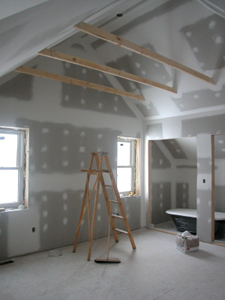December 27, 2010
Lawsuits Imply That There Is Also Something Wrong With American-Made Drywall

By Michael D. Shaw
Many homeowners—especially in Florida—are all too aware of the severe problems caused by tainted and corrosive gypsum wallboard (drywall) imported from China. Hence the term “Chinese drywall.” Now, however, the focus is on some drywall manufactured right here in the good ol’ USA.
Due largely to the bravura efforts of Aaron Kessler, reporter for the Sarasota Herald-Tribune, and Joaquin Sapien of ProPublica, the saga of houses apparently ruined by American board is finally seeing the light of day. Kessler and Sapien report that…
Ninety-seven homeowners in four states have joined lawsuits against U.S. drywall manufacturers in the past year, claiming that their drywall is releasing enough sulfur gas to corrode wiring and appliances and cause headaches, nosebleeds, labored breathing and irritated eyes—complaints that until now have been mostly associated with Chinese drywall.
Until quite recently, the best known case of allegedly tainted American drywall was that of George and Brenda Brincku of Alva, Florida. The Brinckus suffered all the symptoms of Chinese drywall. The only problem is that there was not any Chinese wallboard in their home. Instead, the bulk of it was made by National Gypsum, with a small amount coming from U.S. Gypsum. The Brinckus’ troubles were disseminated via various media in April, 2009.
Eventually, testing would be done on several drywall samples from their home, performed by separate labs and experts hired both by the Brinckus and National Gypsum. To no one’s surprise, the Brincku-sponsored work proved that the drywall was at fault, while the National-sponsored efforts proved just the opposite. The Brincku-sponsored tests also cleared the US Gypsum product.
Some of the plaintiffs claim that the troubles are caused by National’s use of so-called Flue Gas Desulfurization or FGD gypsum. FGD gypsum is created as follows:
In order to release less sulfur dioxide into the air, coal-fired power plants have installed devices called “scrubbers” to remove most of the emissions. The most widely used process involves lime or limestone slurry and acid-base reactions with sulfur dioxide. In essence, calcium oxide (lime) and sulfur dioxide (the pollutant) combine to form calcium sulfite, which is then oxidized to form calcium sulfate (gypsum).
Some of the plaintiffs speculate that sulfides are being produced in the FGD process, and these are the causative factors in the tainted and corrosive drywall. But, there are major flaws in this theory.
Given the chemistry of the FGD gypsum process, it is highly unlikely that sulfides could be produced, since oxidation all the way to sulfates is occurring. Moreover, nearly half of all American drywall is made this way, and FGD gypsum drywall has been around for quite awhile, with no previously reported tainted and corrosive issues.
A more likely possibility, championed by other plaintiffs, is that the drywall in question was produced using recycled wallboard—a commodity that was readily available following the disastrous hurricanes of 2004 and 2005 which prompted the Florida building boom, and the ensuing tainted drywall crisis. Could some of this recycled wallboard have been tainted?
Then, there are those such as construction industry consultant and consumer advocate Michael Foreman who wonder if raw material was imported from China, to be utilized in the manufacture of “American” board. That’s a very good question, but don’t hold your breath waiting for an answer.
Sad to say, the domestic gypsum industry and its trade association have been a good deal less than forthcoming in sharing their expertise in this matter. Furthermore, the entire investigative process seems to be more concerned with obfuscation, wasting time, and spending other people’s money than in actually obtaining results.
Any tainted board, by definition, will be emitting elevated levels of hydrogen sulfide, carbonyl sulfide, and/or carbon disulfide. This can be determined quite readily using ASTM Standard Test Method D5504-08 or similar chamber or headspace testing. Although no standards exist that define what an “elevated” level is, one need only refer to the data in the March, 2010 report issued by the Consumer Product Safety Commission entitled “CPSC Staff Preliminary Evaluation of Drywall Chamber Test Results—Reactive Sulfur Gases.”
There is a tremendous and obvious difference in the levels produced by tainted and good drywall.
Thus, one can perform a visual inspection of the affected home looking for the telltale signs of tainted wallboard, which have been well-documented by CPSC, the State of Florida, and other authorities. After this, drywall samples are taken, focusing on those cavities with the darkest and second darkest copper corrosion shown on electrical outlets and wall switches. These samples would then be subjected to a chamber test.
Foreman notes that with a proper inspection, four samples from a one-level home, and eight samples from a two-level home would suffice to determine the presence—although not the actual quantity—of tainted drywall in the structure.
Until such chamber testing is much more widespread, my observations on the entire investigative process, as stated above, would appear to be accurate. Worse, though, is that affected homeowners continue to be ripped off by many of those who should be helping them.

